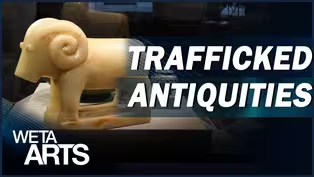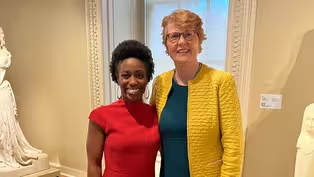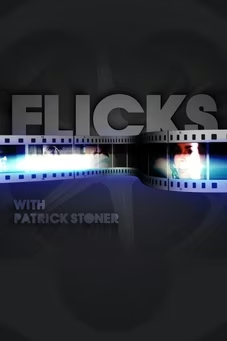
The Smithsonian American Art Museum is Evolving
Clip: Season 11 Episode 8 | 6m 55sVideo has Closed Captions
Smithsonian American Art Museum director shares her vision for the museum's future.
With over 40,000 works by more than 7,000 artists, the Smithsonian American Art Museum offers a captivating journey through the cultural landscape of the United States. Join museum director Stephanie Stebich on a tour of the newly renovated third-floor galleries and a a first hand glimpse of art conservation in action. Along the way, Stebich shares her vision for the museum's future.
Problems playing video? | Closed Captioning Feedback
Problems playing video? | Closed Captioning Feedback
WETA Arts is a local public television program presented by WETA

The Smithsonian American Art Museum is Evolving
Clip: Season 11 Episode 8 | 6m 55sVideo has Closed Captions
With over 40,000 works by more than 7,000 artists, the Smithsonian American Art Museum offers a captivating journey through the cultural landscape of the United States. Join museum director Stephanie Stebich on a tour of the newly renovated third-floor galleries and a a first hand glimpse of art conservation in action. Along the way, Stebich shares her vision for the museum's future.
Problems playing video? | Closed Captioning Feedback
How to Watch WETA Arts
WETA Arts is available to stream on pbs.org and the free PBS App, available on iPhone, Apple TV, Android TV, Android smartphones, Amazon Fire TV, Amazon Fire Tablet, Roku, Samsung Smart TV, and Vizio.
Providing Support for PBS.org
Learn Moreabout PBS online sponsorshipThe Smithsonian American Art Museum has one of the world's largest collections of art created in the United States, with over 40,000 works by more than 7,000 artists.
Stebich: This is a place of wonder and discovery.
We have scavenger hunts if you want to challenge yourself.
Curry: The museum's director Stephanie Stebich gave us a tour of the museum's newly renovated third-floor galleries, and I got to learn more about the museum's history and her goal to increase representation in its exhibits.
You see, we've got higher ceilings.
We can hang more artwork and our larger artworks, too, that need space.
Oof, this.
Stebich: These are strings of LED lights.
They turn on and off.
When they turn on in a certain formation, they create words, and it was especially commissioned for SAAM, and we love it.
I am so excited to be sitting here in the museum.
What a beautiful space to be sitting in.
There's history surrounding the building, specifically D.C. history.
Can you tell us a little bit about that?
Yes, yes, although most days, I would love to be in a building that was purposely designed and built for art, but this is pretty close.
This building was designed as the Patent Office.
We still have a couple of those patent models here in the building.
Also, this building has had many important uses in the history of our country.
The space we're in right now we call affectionately the Lincoln Galleries.
Lincoln had his second inaugural ball here-- some 4,000 people came; you think about the grandeur of the building-- and it was a Civil War hospital at one point.
Clara Barton was here, who would go on to found the Red Cross, and she was a Patent Office clerk, and Walt Whitman was here.
He was reading to the injured.
He was helping people write letters.
♪ Tell us a little bit about the origin story of this particular museum.
So the Smithsonian American Art Museum was the first federal art collection.
One of the earliest collections that came in was focused on European art.
♪ There was a belief, somewhat mistaken, that the great art was only in Europe, and as more collectors and more museums were established, our mission focused on American art.
How does that transformation happen?
Sometimes it takes time, takes an awareness, sense of nationalism.
Also, it takes research, really finding those early American artists.
As our country changes, we need to ensure that we are representing people in the galleries.
We have deep holdings in African American art that reflects the community in which we sit.
We have an Asian American art initiative.
We've also made bigger efforts to add the work of Native American artists.
We want to make sure that your story is told here, and I think it's very important that this museum have a collection of self-taught and folk art, like craft collections or photography, which is an important part of the American story.
This is artwork by Hank Willis Thomas, one of the most exciting artists working today, and this piece is called "Pledge," and it's an image of children saying the Pledge of Allegiance at the moment of Japanese internment... Wow.
and he has a certain photographic process so when you use your flash, the photograph pops out.
I love that.
Photography was a type of collection that museums disdained, so a lot of museums didn't start their photography collections until the 1970s.
We've always been a little earlier, a little bit more advanced, and with a broader definition of art, particularly American art, in all its beautiful diversity.
I know that you had a transformation here in your modern art wing.
How does that speak to how American art is shifting and changing?
When I arrived in 2017, we needed to do a lighting project replacing our lighting system.
Then it became clear that, well, we probably have to move the artwork to ensure that the lighting system was properly installed, there would be no damage.
Well, then, if we're taking things off the wall, is this an opportunity to rethink how we're gonna tell the story?
For example, more work by women artists.
That is an important story and development of the 20th century.
♪ Stebich: There's a lot to love about Alma Thomas, and "Red Azaleas," it's one of her largest works.
No museum can touch us in the way we tell the story of the Washington, D.C., Color school.
We are so deep in the work of Alma Thomas.
We have some 3 dozen works of her.
She's an artist of great local acclaim, and when she passed away, she made a gift of many artworks to the museum, so she thought it was important that she be well-represented here.
Stebich: I love this artwork.
It's called "Sky Cathedral."
It's all black.
It's about a compilation of found materials-- the legs of a table, back of a chair-- and it's a woman artist.
♪ There are many other museums who have American art.
What differentiates you from them?
I would say the variety, but we also have grouped things together so that they have more meaning.
We bring young scholars on board.
We've conservation labs.
Stebich: This is our Frames Studio.
Frames are really important to presenting an artwork well.
Here are our paper laboratories.
This is where the arts doctors work.
We try to show people how conservators work, what kind of equipment we have.
We put things in the windows so that people can see a little bit of the magic, the before and after.
♪ What are the words you say to folks who aren't museumgoers to encourage them to take a minute to walk in?
I sometimes say, "Do you need an art break?"
Right?
It's like a spa moment.
It's just a time in your day where we're gonna look at something.
We're not gonna think about our schedules or our worries, but how does this artwork make me feel in this present moment?
An artwork will have one different meaning in this building and wrapped around 300 years of art from the United States versus being seen in the Hirshhorn, which is showing contemporary art from around the world.
Every museum director thinks their museum is best.
I'm feeling pretty confident that we lead in the story of American art.
Stephanie, thank you so much for having us here.
We have really enjoyed having this conversation with you.
Thank you.
Curry: You can see the renovated third floor for yourself as well as special exhibitions and events at the Smithsonian American Art Museum at 8th and G Streets NW near the Gallery Place-Chinatown Metro stop.
Check the website at americanart.si.edu for information on current and upcoming exhibitions.
How the United States and Yemen Work Together to Combat Art Crime
Video has Closed Captions
Clip: S11 Ep8 | 9m 12s | Law enforcement officials battle art crime, which has had devastating impacts across the world. (9m 12s)
Preview: S11 Ep8 | 30s | Yemen’s repatriated antiquities; Classical Indian Dance; Smithsonian American Art Museum (30s)
Step into the World of Bharatanatyam, a Classical Indian Dance Form
Video has Closed Captions
Clip: S11 Ep8 | 9m 3s | A Potomac, MD dance studio teaches Bharatanatyam, a classical Indian dance form. (9m 3s)
Providing Support for PBS.org
Learn Moreabout PBS online sponsorshipSupport for PBS provided by:
WETA Arts is a local public television program presented by WETA


















